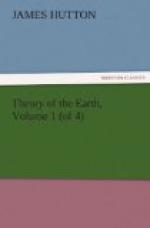It will be very remarkable if similar appearances are always found upon the junction of the alpine with the level countries. Such an appearance, I am inclined to think, may be found in the Val d’Aoste, near Yvree. M. de Saussure describes such a stone as having been employed in building the triumphal arch erected in honour of Augustus. “Cet arc qui etoit anciennement revetu de marbre, est construit de grands quartiers d’une espece assez singuliere de poudingue ou de gres a gros grains. C’est une assemblage de fragmens, presque touts angulaires, de toutes sortes de roches primitives feuilletees, quartzeuses, micacees; les plus gros de ces fragmens n’atteignent pas le volume, d’une noisette. La plupart des edifices antiques de la cite l’Aoste et de ses environs, sont construits de cette matiere; et les gens du pays sont persuades que c’est une composition; mais j’en ai trouve des rochers en place dans les montagnes au nord et au-dessus de la route d’Yvree.”
We may now come to this general conclusion, that, in this example of horizontal and posterior strata placed upon the vertical schisti which are prior in relation to the former, we obtain a further view into the natural history of this earth, more than what appears in the simple succession of one stratum above another. We know, in general, that all the solid parts of this earth, which come to our view, have either been formed originally by subsidence at the bottom of the sea, or been transfused in a melted state from the mineral regions among those solid bodies; but here we further learn, that the indurated and erected strata, after being broken and washed by the moving waters, had again been sunk below the sea, and had served as a bottom or basis on which to form a new structure of strata; and also, that those new or posterior strata had been indurated or cemented by the consolidating operations of the mineral region, and elevated from the bottom of the sea into the place of land, or considerably above the general surface of the waters. It is thus that we may investigate particular operations in the general progress of nature, which has for object to renovate the surface of the earth necessarily wasted in the operation of a world sustaining plants and animals.
It is necessary to compare together every thing of this kind which occurs; it is first necessary to ascertain the fact of their being a prior and posterior formation of strata, with the mineral operations for consolidating those bodies formed by collection of the moveable materials; and, secondly, it is interesting to acquire all the data we can in order to form a distinct judgment of that progress of nature in which the solid body of our land is alternately removed from the bottom of the sea into the atmosphere, and sunk again at the bottom of the sea.
I shall now transcribe what M. Schreiber has wrote in relation to this subject. It is in a memoir concerning the gold mine of Gardette, published in the Journal de Physique.




